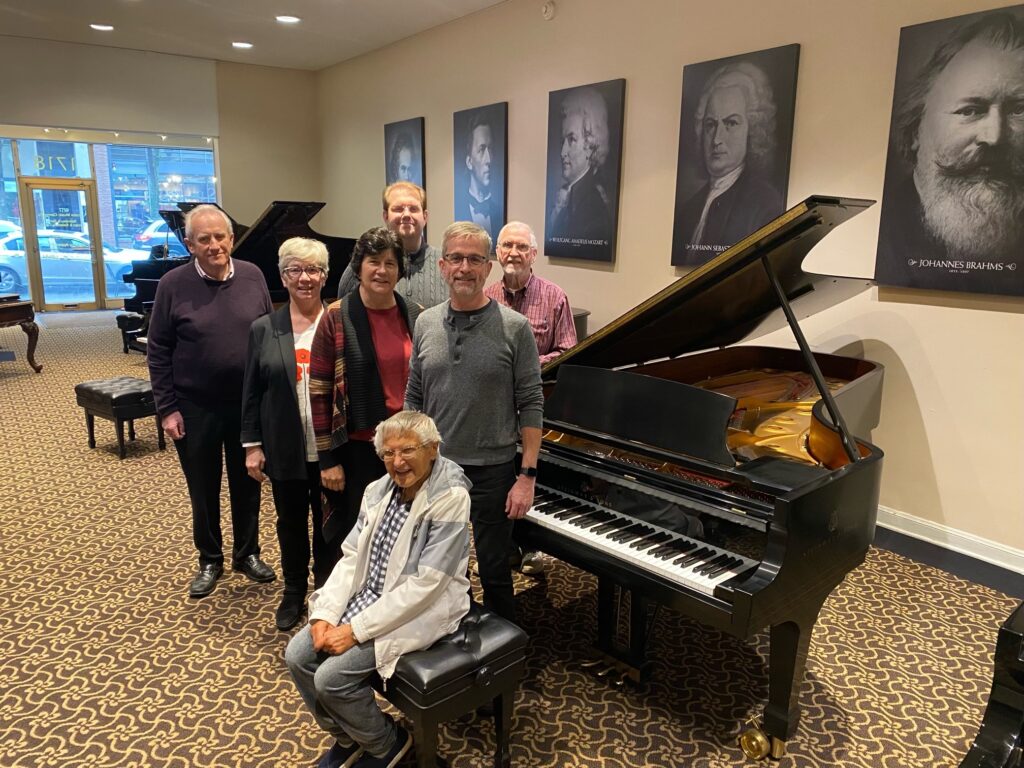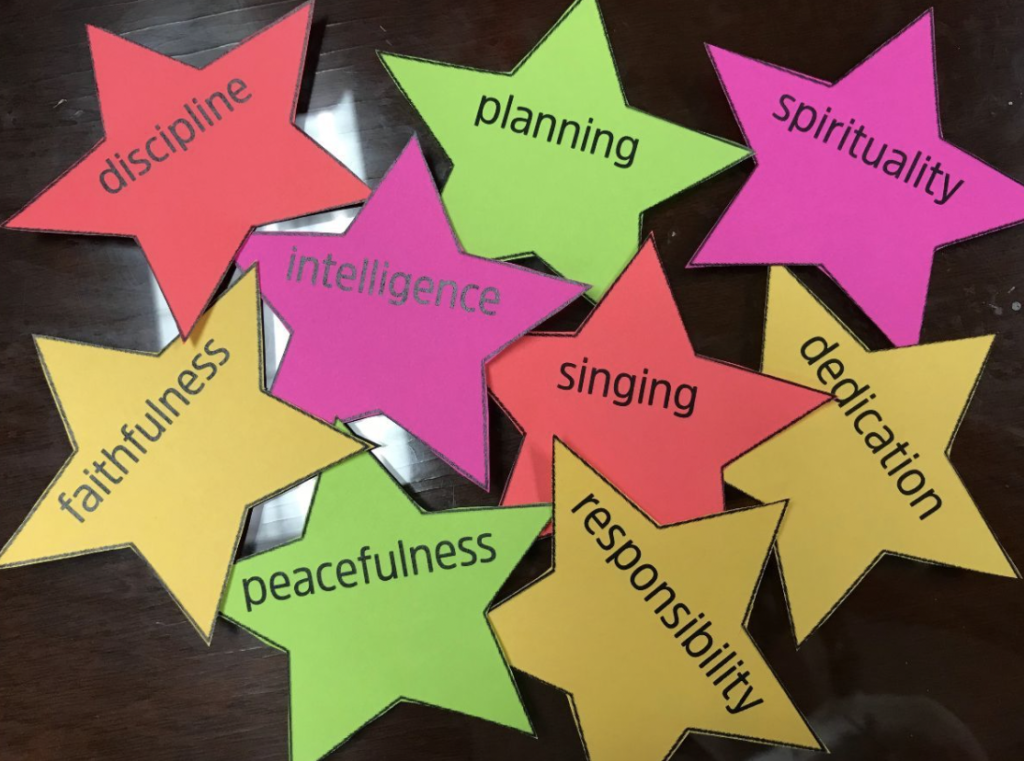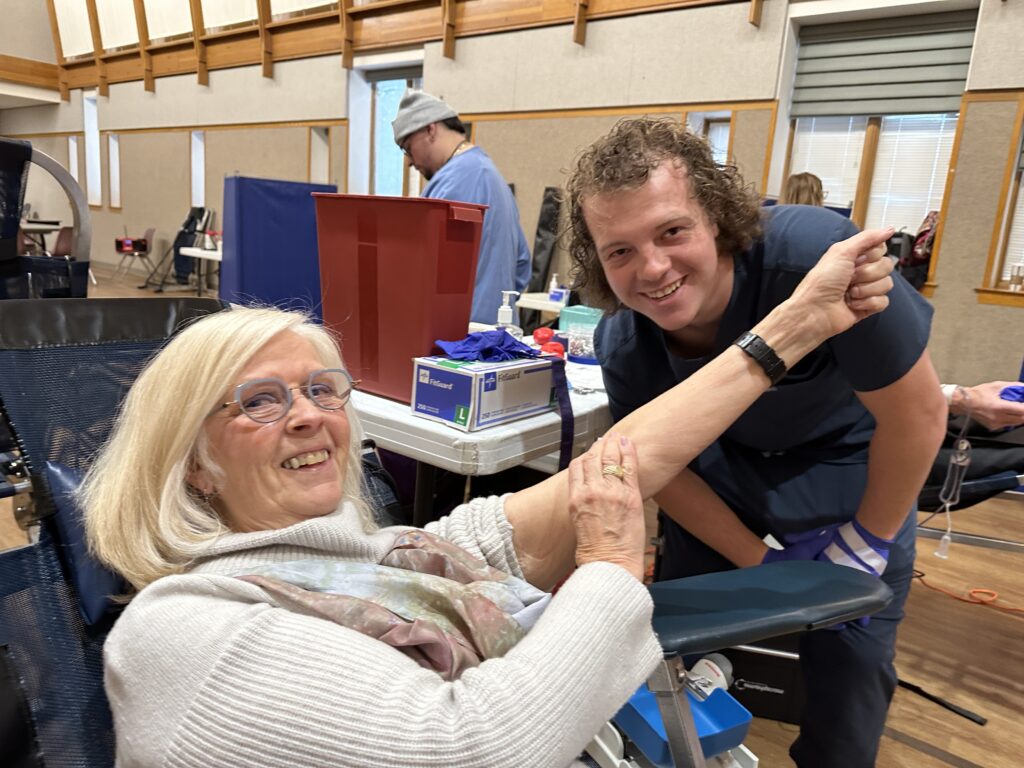News
Save the Date: 2024 Heritage Trip
January 4, 2023As part of Derry’s 300th anniversary celebration, plans are under way for a group tour to Scotland and Ireland April 11-25, 2024. Mark your calendars now: trip details coming soon.
Sign Up to Have Your Photo Taken for the New Pictorial Directory
January 4, 2023Over the next four Sundays, Sue George will be available to take photos of families and individuals who would like to have a new photo for the church’s pictorial directory that will publish in February.
All photos are taken outside the main courtyard entrance — the lighting there makes everyone look beautiful. Two families or individuals can sign up in each time slot: click here to pick the time that works for you.
You can also submit a head shot: send it by email to Sue George or stop by the church office and we’ll scan and return the photo to you.
Derry Has At Least Two Musical Minds
January 4, 2023The conversation you overheard if you watched the 2022 staff Christmas video references 31 holiday songs, and as far as we know, only two Derry friends found all of them. Congratulations to Mike Klucker and Pam Whitenack for listening close enough to detect all of the references. We are in awe of your knowledge of Christmas music!
Christmas Eve at Derry Church
December 21, 2022SATURDAY, DEC 24 IN THE SANCTUARY • LIVE STREAM AT 5 PM & 7:30 PM
2:30 pm: Worship includes Lessons and Carols and communion, with holiday music presented by the Derry Brass. Arrive early to enjoy their Christmas carol prelude beginning at 2:15 pm.
5:00 pm: A candlelight service of Lessons and Carols featuring participation by children and music for the entire family to enjoy.
7:30 pm: A traditional Christmas Eve candlelight service of Lessons and Carols, with music presented by the Derry Ringers handbell choir and the Sanctuary Choir. Prelude and live stream begin at 7:15 pm.
Click here to view and download the Christmas Eve bulletin
Click here to join the 5 pm live stream
Click here to join the 7:30 pm live stream
Child care available at 5 pm and 7:30 pm. The lounge adjacent to the Sanctuary offers a candle-free worship zone and a space where young families can move about freely.
On Sunday, Dec 25 worship at 10:30 am in the Sanctuary or live stream. The prelude is a Christmas carol sing that begins at 10:20 am. Enjoy Christmas breakfast cooked by Charlie Koch and friends from 9-10:30 am in Fellowship Hall: your donation benefits mission trips in 2023.
Dec 2022 Financial Snapshot
December 21, 2022Cash Flow – Operating Fund as of 11/30/22
| ACTUAL | BUDGETED | |
| Income YTD: | $1,191,212 | $1,145,833 |
| Expenses YTD: | 1,023,500 | 1,186,110 |
| Surplus/(Deficit) YTD: | 167,712 | (40,277) |
Notes from the treasurer:
- Contributions are about $74K ahead of 2021 and $40K ahead of estimated contributions through November.
- Building and grounds is about $46K below budget. We do expect to roll some of this into 2023.
- Some personnel expenses are backloaded.
Derry Church Piano Committee Recommendation and Invitation
December 21, 2022
Recently a committee was created to consider if Derry Church needs a new piano for the Sanctuary to better support worship services and music programs. The committee is chaired by Dick Hann and includes Janice Click Holl, Mary Lemons, Dan Dorty, Greg Taylor, Bruce McKinney, and Randy Aires.
Our current Sanctuary piano, a 6 foot 7 inch Yamaha, was generously donated by Margaret Bachman in 2006. It is a good piano that was designed for a living room and not a space the size of our Sanctuary. If we decide to move forward with a new piano, the Yamaha will be moved to the Chapel where it will really shine in that intimate space.
The committee looked at several options (new and used) and after visiting a Steinway store in November with Shelly Moorman-Stahlman and world renowned pianist Ruth Slenczynska, they unanimously recommended a 2019 Model D Steinway. This 9-foot instrument is designed for use in a larger space and will provide a fuller sound to better support congregational singing, choral anthems, soloists and musical performances. Click here to learn more.
This piano is a unique a first-class instrument. It will be one of, if not the, best piano in central Pennsylvania churches and concert halls. It’s a piano that will attract top musicians for Arts Alive concerts and more.
The committee recommends that the piano, if purchased, be dedicated as the Lee Ann Taylor Memorial Piano. Lee Ann was passionate about music, especially piano, and greatly contributed to music at Derry as an accompanist, bell ringer, and volunteer choir director.
A final decision to purchase the piano has not been made. We have the opportunity to try the new piano in our Sanctuary and to hear feedback from the congregation. At the 10:30 am service on Sunday, Jan 8 you’ll see two pianos on the chancel: our Yamaha and the new Steinway. We’ll sing hymns using both pianos so we can determine the difference between the two, and hear the pianos for preludes, a postlude, and accompanying Amy Yovanovich for anthems.
Come back at 4 pm Sunday, Jan 8 for a recital by Dan Stokes, Dan Dorty, Mary Lemons, and others as they play a range of musical styles and give the piano a workout. Your feedback is welcome and appreciated. Should the way be clear to proceed with the purchase, a fundraising campaign will begin with the goal of raising the total purchase cost of $150,000.
If you have questions about the Steinway, or why it is being recommended, please reach out to Dan Dorty or Dick Hann.
Merry Christmas from the Derry Church Staff
December 21, 2022It’s the final staff meeting before Christmas Eve. Watch and listen carefully because this is no ordinary meeting: the staff slips lines from Christmas songs into their conversation. Tell Pastor Stephen how many lines you heard by Dec 31, 2022 and we’ll recognize the person who finds the most.
Thank You for Gifts to PW’s Thank Offering!
December 21, 2022THANK YOU to all who supported this year’s Thank Offering of $2,688! Derry Church’s Presbyterian Women thanks you for your gifts.
On Christmas Day, take a moment to remember and pray for all the females who are victims of exploitation locally, statewide, nationally as well as internationally. The 25th of every month is Orange Day, and an orange ribbon will make a great accent to your red and green attire on Christmas.
Epiphany is Coming… and so are Star Gifts!
December 21, 2022Come to church at 10:30 am on Epiphany Sunday, Jan 1 to worship and to choose a star gift for 2023! Baskets of stars will be at the Chapel and Sanctuary entrances. Choose a star gift and reflect on that word for the coming year. Take it home and hang it up where you can see it every day. Ponder what significance this word might have in your life, and how God might be speaking to you through that simple message.

New Year’s Eve 2022 in Hershey
December 21, 2022Hershey New Year’s Eve returns on Dec 31 with a full celebration for its 18th year. Organizers are excited to announce that revelers will enjoy live bands, great food and drinks, and family-friendly activities culminating in the Hershey Kiss raise at midnight and a fireworks display. Click to view the 2022 schedule.
Blood Drive Report
December 14, 2022The Central Pennsylvania Blood Bank reports these figures from Derry’s blood drive on Sunday, Dec 11:
- 36 people registered to donate.
- 30 units of blood were collected: these are great percentages!
- Derry Church donors helped to save up to 90 lives
Thanks to everyone who participated in some way to make the blood drive a success.

Congregational Meeting on Jan 1
December 14, 2022The Session has called a special congregational meeting for Sunday, January 1, 2023 following the 10:30 am worship service to elect Jennifer Toth Reed as a Deacon, Class of 2025. She has been nominated to fill the position vacated by Bill McGregor.